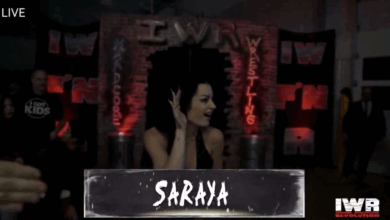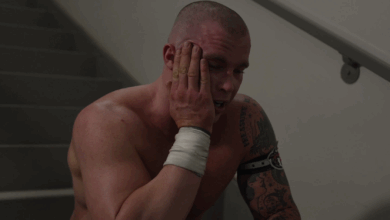Exclusive Analysis: Roman Reigns vs. Dean Ambrose WWE House Show Attendance Comparison

As house show draws, both Roman Reigns and Dean Ambrose can be viewed as performing equally so far in 2016. While both have been leaders of the separate house show tours, neither seem to have a significant effect on house show attendance. Meanwhile, the absences of John Cena, Seth Rollins and Randy Orton seem to be contributing to the overall decline in house show attendance this year.
Explanation of how this research was formulated
I did a market-to-market analysis to draw those conclusions, rather than calculating simple averages. I took all the North American (U.S. and Canada) house shows that were led separately by Ambrose and Reigns this year as of July 23 and compared them to the average house show attendance in each city from 2012 to 2015, controlling for house shows during that time that featured Cena. I also discarded three shows’ attendances because Brock Lesnar was featured, one that had Triple H and the only two North American house shows Cena appeared on. When comparing Reigns and Ambrose, I only looked at shows that they worked where the other did not appear; there were a handful of house shows they both appeared on that obviously should not be considered when directly comparing the performance of the two. Attendances were sourced from the Wrestling Observer Newsletter.
The cities WWE runs house shows in obviously have a variety of population sizes and levels of interest in WWE. A market-to-market analysis is fairer than simply averaging house show attendances (in which case, Ambrose would beat Reigns handily, 4,425 to 3,830). Comparing an attendance to what we can expect it to be based on previous shows in that very city controls for those factors. It should be noted that for some cities, comparisons were impossible simply because there were no house shows in the given city from 2012 to 2015 either with Cena or without him, or, in a handful of cases, because a house show in the city took place but the attendance was not reported in the Observer. Since we’re only looking at house attendance here, attendances for TV tapings obviously are not considered.
Roman Reigns vs. Dean Ambrose
For years, WWE has run house show tours on weekends, using two leading headliners on separate shows so the company can often run two events in different parts of the country on the same day. In recent years, Cena has always been the leader of one tour, carrying most of the larger markets, while the likes of Randy Orton, Daniel Bryan or, last year, Reigns carried the other tour.
Cena went down with a shoulder injury at the tail-end of 2015. Even since his return to television, it looks like he’s indefinitely finished regularly working house shows. That’s left those non-televised events this year to be carried by a Reigns tour and an Ambrose tour.
Counter to what you might think, Reigns was not given the bigger markets; Ambrose was. Reigns has been the most protected star in WWE over the last two years, only with the possible exception of Cena. So you might think, with Cena out, Reigns would assume the larger markets usually reserved for the fifteen-time world champion. That was not the case. For whatever reason — possibly because Cena’s absence due to injury was not anticipated, and Reigns’ schedule was already set and advertised — Ambrose headlined in 13 of the 14 most populous cities where only one or the other of them appeared (Toronto, Calgary, Jacksonville, Winnipeg, Denver, Boston, Minneapolis, Tulsa, Honolulu, London [Ontario], Corpus Christi, Orlando and Louisville). Reigns’ biggest city was Raleigh, North Carolina. Reigns also headlined in San Jose, but that was with Lesnar. Likewise, Ambrose headlined in two bigger cities with Lesnar: Houston and Montreal.
Reigns/Ambrose vs. Non-Cena numbers
Let’s look at Reigns’ performance first. Cena has shown to be a real difference-maker to house show attendance in earlier research, which, as we’ll see later, the analysis for this article only reinforces. So let’s keep Cena out of the equation for now, and just compare Reigns’ attendances to the average in those cities from 2012-2015 when Cena wasn’t there. Since Reigns himself was often the headliner we are comparing him to here, we can expect attendance to be about the same in each case.
Out of nine cases, Reigns has a 2-7 record. He drew more on two occasions, and less on seven. The average difference by percentage he made to attendance so far this year by this comparison is -8%.
What about Ambrose? Let’s compare his house shows to the same “non-Cena” criteria.
Because Reigns missed some time due to nose surgery in the weeks before WrestleMania, and due to his 30-day suspension for violating the WWE Wellness Policy, Ambrose worked more house shows, and therefore has more samples for this study.
In 16 cases, Ambrose has a 7-8-1 record. That’s a better record than Reigns, but the average difference by percentage he makes to attendance under this criteria, -6%, is barely higher than Reigns’ average. That metric was hurt especially by low turnouts in Charleston, West Virginia, and Charlottesville, Virginia, down 54% and 63%, respectively, despite good turn outs in London, Ontario and Louisville, Kentucky.
Reigns/Ambrose vs. Cena numbers
How do Reigns and Ambrose’s attendances compare when the mighty John Cena was in those cities?
Reigns was ahead of Cena’s average in two cities, behind in eight. Attendance is an average of 29% lower when Reigns is the headliner versus when Cena is.
And Ambrose?
Ambrose beat Cena’s average in three cities. Cena beats him in the other twelve. Attendance is 21% lower with Ambrose as opposed to Cena. Ambrose retained Cena’s attendance slightly more effectively than Reigns, but the difference Cena makes to house show attendance is significant.
Was North American house show attendance from 2012 to 2015 a stable metric, though? Is it possible that particular years performed so well or poorly that the data that we’re comparing Reigns and Ambrose’s performances against is skewed?
While average attendance was a few hundred higher in 2013, the other years are similar. So this is a fairly stable metric that hasn’t drastically fluctuated over the years we’re concerned with here.
More importantly, it’s reasonable to ask whether who’s advertised on WWE house shows really matters to the people who consider buying tickets. While specific matches themselves are often not advertised at all, you can however find on WWE.com (as well as other advertising materials) which wrestlers will be appearing on each show.
For some purely anecdotal evidence, I asked on Twitter whether anyone had ever weighed buying house show tickets based on who was advertised to be on the show. For whatever it’s worth, a surprising number of people told me they did, and none affirmed that it didn’t matter. Granted that’s a few among a small population of people who are hardcore enough to follow a guy on Twitter who posts a lot of graphs of about pro wrestling business.
But the fact that Cena beat both Ambrose and Reigns in the same markets almost every time, and furthermore, that he makes such a consistent difference to house show attendance overall, market-to-market, in the last several years, makes it pretty clear that — at least, in Cena’s case — it does matter to ticket-buyers who’s on the card.
Neither Ambrose or Reigns vs. Non-Cena numbers
We can’t even say that Ambrose or Reigns make any meaningful difference to attendance, positive or negative. There were 13 shows for which we have attendances that had neither Ambrose nor Reigns (nor Cena nor Lesnar nor Triple H), which fared about as well as the two tour leaders.
Ten of these thirteen events were actually main evented by Bray Wyatt. These events’ attendances were down an average of 4% from where we would expect them to be based on attendances in the same city from 2012-2015 without Cena, actually slightly better than both Reigns (-8%) and Ambrose (-6%) by the same measurement: differences so small among these few samples that they are probably not meaningful. In other words, this tells us it doesn’t really matter, positively or negatively, to house show attendance whether Reigns or Ambrose are on the show or not.
Attendance actually suffered quite a bit less when compared to Cena’s average in the city, versus when Reigns (-29%) or Ambrose (-21%) where there. But attendance was down more often, case-by-case, than it was for Ambrose: down ten out of thirteen times, up twice and the same once.
It’s apparent from this study that Reigns has not caught on as intended. The company invested a great of TV time trying to establish him as a new top babyface over the last two years, and has gotten little return on that investment. While Cena was booed somewhat as well during his rise to stardom, this is different. Whatever reaction Cena got on any given night, he made a positive difference to business, as evidenced in this article. You might argue Reigns is a face to some fans and a great heel to those fans who boo him, but he’s not drawing any better than Ambrose, who is a guy who often couldn’t muster wins on pay-per-views since the Shield was disbanded, while Reigns was frequently in the title picture at the same time.
The spreadsheet for the data referenced in this article is here.
Thanks again to Chris Harrington, who collected much of the 2012-2015 attendances from the Observer.




